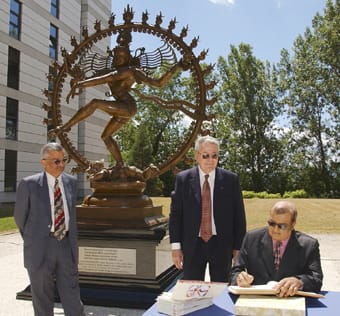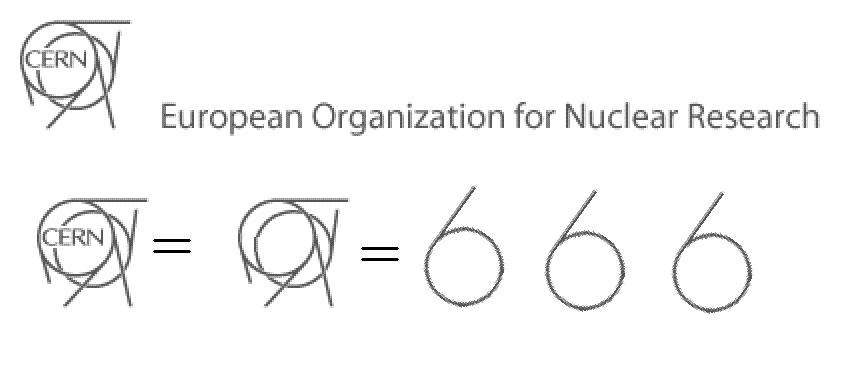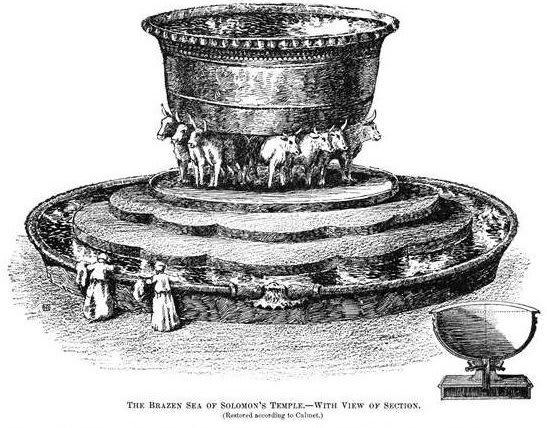For my next blog-post, I thought that I would go back to the roots of this thing, and write something about the Tower of Babel again. I turned to social media with this question: What is our generation’s “Tower of Babel”? The results have been … interesting. I’ll soon be posting another couple of articles about everything else folks had to say to me. But a number of people suggested something that took me off guard: CERN.
What is CERN?
CERN (an abbreviation for Conseil européen pour la recherche nucléaire) is a multi-national nuclear research organization. They are probably most famous for running the “Large Hadron Collider,” the largest machine in the world. (Can you see where some of this might be heading yet?). The LHC collides particles into one another at incredible speeds. It helped to measure the properties of the “Higgs boson.” In fact, the LHC produced a subatomic particle that matched the proposed properties of the Higgs boson back in 2012.
All of this is pretty heady science. When dealing with quantum particle physics, there is lots of room for misunderstanding and sensationalism. Because the press popularly referred to the Higgs boson as the “God particle,” the sensationalism just grew and grew. And because Dan Brown (of DaVinci Code infamy) had already made particle research at CERN a big part of the plot of his Angels and Demons (later made into a film in 2009) I suppose that all of the ingredients were sitting right there for a spiritual conspiracy theory involving CERN.
CERN: Conspiracy Element 1
CERN Is Going to Blow Up the Universe!!!
Someone directed me to an article that they had written detailing their version of the theory. Some of what they have to say sounds a bit like Dan Brown’s convoluted ideas in Angels and Demons. So Dan Brown used the supposed threat of CERN developing anti-matter as a plot device. (As I understand it, to actually develop enough anti-matter for such purposes, and then to keep it stable up to the moment of deployment, is so incredibly cost-prohibitive as to render the entire plot of Brown’s novel farcical).
This individual with whom I have been having correspondence invokes Stephen Hawking. Somewhere Hawking supposedly said that the LHC “could pose grave dangers to our planet…the God Particle (also known as the Higgs Boson Particle) found by CERN could destroy the universe.” My correspondent summarizes the rest of Hawking’s explanation as to why this could happen. Supposedly, Hawking said that the energy generated in the LHC might create a “vacuum bubble” that would ripple through the delicate fabric of space and time, causing them to collapse in on themselves. This is what Hawking refers to as “vacuum decay.”
What Stephen Hawking Really Said
Except that Hawking never said just those words in just that order. As far as I can determine, the basis for this claim is something that Hawking wrote in the preface to a book called Starmus. This is what he actually said, “The Higgs potential has the worrisome feature that it might become metastable at energies above 100 [billion] gigaelectronvolts (GeV). This could mean that the universe could undergo catastrophic vacuum decay, with a bubble of the true vacuum expanding at the speed of light. This could happen at any time and we wouldn’t see it coming.”
Notice, Hawking is not talking about the Higgs boson in that quote, but the Higgs potential. These are two completely different things. Basically, he is suggesting that our universe is actually somewhat fragile. Because one bug of our universe is this Higgs potential trait, if something managed to generate 100 billion GeV of energy, it could instigate vacuum decay. And please note: Hawking does not suppose that the source of this energy might come from CERN. If it happens, it will be random. It “could happen at any time and we wouldn’t see it coming.”
By the way, a machine capable of generating that much GeV of energy would be larger than our planet. CERN is not really a threat on that front, at least.
Supposedly Neil de Grasse Tyson has also warned us of the dangers of what CERN is doing, but I can’t find any trace of these warnings.
CERN: Conspiracy Element 2
One of the things that bothers Christian CERN conspiracy theorists is the presence of a large statue of Shiva on the premises. My correspondent asks, “Why does a science facility have this on their lawn?”
Actually, there seems to be a fairly innocuous explanation. CERN is an international research facility. One of the member nations is India. Evidently India donated the statue as a gift in 2004. You can read about it here.

CERN: Conspiracy Element 3
Another element of the CERN conspiracy theory has to do with it’s logo.

Do you see it? This helpful drawing might help you out:

I don’t see it. No matter how I squint, I can’t get “666” out of CERN’s logo. I can only find two circles for two sixes, not three. And there are two too many stems!
In any case, the number of the beast is not what most people think it is.
CERN: Conspiracy Element 4
But the most perplexing thing to me about this conspiracy theory is the claim that CERN is using the LHC to open portals through which demons will invade our planet.

Supposedly this was the original function of the Tower of Babel, and CERN is trying to accomplish what the folks in Genesis 11 could not.
Here is one example that someone sent to me, from the Jim Bakker Show. (You do remember him, don’t you?).
Strangely, I have had a few Catholic correspondents tell me the same things this video argues.
Why CERN Can’t Build a Demon-Portal (Even if They Wanted to Do So)
How Angels Can Be in a Place
I cannot stress how absurd this is, especially for certain Catholic conspiracy theorists. The reason is this: angelic beings do not have material bodies that require physical portals for their movement. Who better to explain angelic movement than the angelic doctor? St. Thomas Aquinas explains, beginning with what it means for an angel to be in a place:
It is befitting an angel to be in a place; yet an angel and a body are said to be in a place in quite a different sense. A body is said to be in a place in such a way that it is applied to such place according to the contact of dimensive quantity; but there is no such quantity in the angels, for theirs is a virtual one. Consequently an angel is said to be in a corporeal place by application of the angelic power in any manner whatever to any place.
Summa Theologiae, Prima Pars, Q. 52, 1
A Further Explanation
Serge-Thomas Bonino, OP, has offered a helpful commentary on this difficult passage in his Angels and Demons: A Catholic Introduction.
An angel, being incorporeal, cannot be situated in a place in the same way as a body is localized. However, as St. Thomas already explained in reference to God, an incorporeal being is present, by dint of a virtual contact, wherever it acts. Thus an angel (or a demon) is present to the corporeal substance to which he applies his causality, not as though he were contained in that corporeal reality but rather as that which somehow contains it.
Bonino, Angels and Demons, pg. 123.
How Angels Travel
The consequences of this for angelic movement should be readily apparent, but let us hear what Aquinas has to say, anyhow:
An angel can successively quit the divisible place in which he was before, and so his movement will be continuous. And he can all at once quit the whole place, and in the same instant apply himself to the whole of another place, and thus his movement will not be continuous.
Summa Theologiae, Prima Pars, Q. 53, 1
In the next article, Thomas explicitly states that angels do not have to move through “mid-space” because they do not have bodies.
The actual passing from one extreme to the other, without going through the mid-space, is quite in keeping with an angel’s nature; but not with that of a body, because a body is measured by and contained under a place; hence it is bound to follow the laws of place in its movement. But an angel’s substance is not subject to place as contained thereby, but is above it as containing it: hence it is under his control to apply himself to a place just as he wills, either through or without the intervening place.
Summa Theologiae, Prima Pars, Q. 53, 2
Bonino’s Explanation
Bonino is again helpful on this point.
Since an angel is not in a place in the same manner as a body is, his displacement—his passage from one place to another—is not of the same type as that of a body. In particular, the translation of a body is continuous, in the sense that a moving thing must pass through all the points between A and B, whereas the displacement of an angel is discontinuous, discrete.
Bonino, Angels and Demons, pg. 124.
I was talking with a good friend about this the other day, and he shared a nice perspective on this. We might say that angels travel to us by shifting their attention to us.
Conclusion
To sum up, demons are not supervillians that depend on portals to enter our world. Unfortunately, they are already here.
Of course, it is hardly surprising that conspiracy theories run wild when folks at CERN do stunts like this one.



















